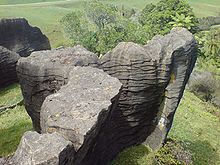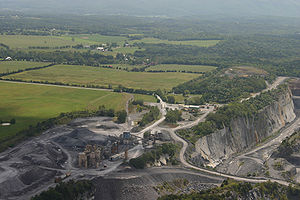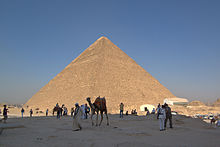- Limestone
-
For other uses, see Limestone (disambiguation).
Limestone Sedimentary Rock 
Limestone in Waitomo District, New ZealandComposition Calcium carbonate: inorganic crystalline calcite and/or organic calcareous material Limestone is a sedimentary rock composed largely of the minerals calcite and aragonite, which are different crystal forms of calcium carbonate (CaCO3). Many limestones are composed from skeletal fragments of marine organisms such as coral or foraminifera.
Limestone makes up about 10% of the total volume of all sedimentary rocks. The solubility of limestone in water and weak acid solutions leads to karst landscapes, in which water erodes the limestone over thousands to millions of years. Most cave systems are through limestone bedrock.
Limestone has numerous uses, including as a building material, as aggregate to form the base of roads, as white pigment or filler in products such as toothpaste or paints, and as a chemical feedstock.
Contents
Description


Limestone quarry at Cedar Creek, Virginia, USA Limestone is a sedimentary rock composed largely of the minerals calcite and aragonite, which are different crystal forms of calcium carbonate (CaCO3). Like most other sedimentary rocks, limestone is composed of grains; however, most grains in limestone are skeletal fragments of marine organisms such as coral or foraminifera. Other carbonate grains comprising limestones are ooids, peloids, intraclasts, and extraclasts. These organisms secrete shells made of aragonite or calcite, and leave these shells behind after the organisms die.
Limestone often contains variable amounts of silica in the form of chert (chalcedony, flint, jasper, etc.) or siliceous skeletal fragment (sponge spicules, diatoms, radiolarians), and varying amounts of clay, silt and sand (terrestrial detritus) carried in by rivers.
Some limestones do not consist of grains at all, and are formed completely by the chemical precipitation of calcite or aragonite, i.e. travertine. Secondary calcite may be deposited by supersaturated meteoric waters (groundwater that precipitates the material in caves). This produces speleothems, such as stalagmites and stalactites. Another form taken by calcite is oolitic limestone, which can be recognized by its granular (oolite) appearance.
The primary source of the calcite in limestone is most commonly marine organisms. Some of these organisms can construct mounds of rock known as reefs, building upon past generations. Below about 3,000 meters, water pressure and temperature conditions cause the dissolution of calcite to increase nonlinearly, so limestone typically does not form in deeper waters (see lysocline). Limestones may also form in both lacustrine and evaporite depositional environments.[1][2]
Calcite can be either dissolved or precipitated by groundwater, depending on several factors, including the water temperature, pH, and dissolved ion concentrations. Calcite exhibits an unusual characteristic called retrograde solubility, in which it becomes less soluble in water as the temperature increases.
Because of impurities, such as clay, sand, organic remains, iron oxide and other materials, many limestones exhibit different colors, especially on weathered surfaces.
Limestone may be crystalline, clastic, granular, or massive, depending on the method of formation. Crystals of calcite, quartz, dolomite or barite may line small cavities in the rock. When conditions are right for precipitation, calcite forms mineral coatings that cement the existing rock grains together, or it can fill fractures.
Travertine is a banded, compact variety of limestone formed along streams, particularly where there are waterfalls, and around hot or cold springs. Calcium carbonate is deposited where evaporation of the water leaves a solution supersaturated with the chemical constituents of calcite. Tufa, a porous or cellular variety of travertine, is found near waterfalls. Coquina is a poorly consolidated limestone composed of pieces of coral or shells.
During national metamorphism that occurs during the mountain building process (orogeny), limestone recrystallizes into marble.
Limestone is a parent material of Mollisol soil group.
Classification
Two major classification schemes, the Folk and the Dunham, are used for identifying limestone and carbonate rocks.
Folk classification
Main article: Folk classificationRobert L. Folk developed a classification system that places primary emphasis on the detailed composition of grains and interstitial material in carbonate rocks. Based on composition, there are three main components: allochems (grains), matrix (mostly micrite), and cement (sparite). The Folk system uses two-part names; the first refers to the grains and the second is the root. It is helpful to have a petrographic microscope when using the Folk scheme, because it is easier to determine the components present in each sample.[3]
Dunham classification
Main article: Dunham classificationThe Dunham scheme focuses on depositional textures. Each name is based upon the texture of the grains that make up the limestone. Robert J. Dunham published his system for limestone in 1962; it focuses on the depositional fabric of carbonate rocks. Dunham divides the rocks into four main groups based on relative proportions of coarser clastic particles. Dunham names are essentially for rock families. His efforts deal with the question of whether or not the grains were originally in mutual contact, and therefore self-supporting, or whether the rock is characterized by the presence of frame builders and algal mats. Unlike the Folk scheme, Dunham deals with the original porosity of the rock. The Dunham scheme is more useful for hand samples because it is based on texture, not the grains in the sample.[4]
Types
There are many types of limestone the most common ones: Chalk, crystalline, fossilferous, oolitic and travertine. For more see link below.
Main article: List of types of limestoneLimestone landscape
Main article: Karst topographyLimestone makes up about 10% of the total volume of all sedimentary rocks.[5][6]
Limestone is partially soluble, especially in acid, and therefore forms many erosional landforms. These include limestone pavements, pot holes, cenotes, caves and gorges. Such erosion landscapes are known as karsts. Limestone is less resistant than most igneous rocks, but more resistant than most other sedimentary rocks. It is therefore usually associated with hills and downland, and occurs in regions with other sedimentary rocks, typically clays.
Karst topography and caves develop in limestone rocks due to their solubility in dilute acidic groundwater. The solubility of limestone in water and weak acid solutions leads to karst landscapes. Regions overlying limestone bedrock tend to have fewer visible above-ground sources (ponds and streams), as surface water easily drains downward through joints in the limestone. While draining, water and organic acid from the soil slowly (over thousands or millions of years) enlarges these cracks, dissolving the calcium carbonate and carrying it away in solution. Most cave systems are through limestone bedrock. Cooling groundwater or mixing of different groundwaters will also create conditions suitable for cave formation.
Coastal limestones are often eroded by organisms which bore into the rock by various means. This process is known as bioerosion. It is most common in the tropics, and it is known throughout the fossil record (see Taylor and Wilson, 2003).
Bands of limestone emerge from the Earth's surface in often spectacular rocky outcrops and islands. Examples include the Burren in Co. Clare, Ireland; the Verdon Gorge in France; Malham Cove in North Yorkshire and the Isle of Wight,[7] England; on Fårö near the Swedish island of Gotland, the Niagara Escarpment in Canada/United States, Notch Peak in Utah, the Ha Long Bay National Park in Vietnam and the hills around the Lijiang River and Guilin city in China.
The Florida Keys, islands off the south coast of Florida, are composed mainly of oolitic limestone (the Lower Keys) and the carbonate skeletons of coral reefs (the Upper Keys), which thrived in the area during interglacial periods when sea level was higher than at present.
Unique habitats are found on alvars, extremely level expanses of limestone with thin soil mantles. The largest such expanse in Europe is the Stora Alvaret on the island of Öland, Sweden. Another area with large quantities of limestone is the island of Gotland, Sweden. Huge quarries in northwestern Europe, such as those of Mount Saint Peter (Belgium/Netherlands), extend for more than a hundred kilometers.
The world's largest limestone quarry is at Michigan Limestone and Chemical Company in Rogers City, Michigan.[8]
Uses
Limestone is very common in architecture, especially in Europe and North America. Many landmarks across the world, including the Great Pyramid and its associated complex in Giza, Egypt, are made of limestone. So many buildings in Kingston, Canada were constructed from it that it is nicknamed the 'Limestone City'.[9] On the island of Malta, a variety of limestone called Globigerina limestone was, for a long time, the only building material available, and is still very frequently used on all types of buildings and sculptures. Limestone is readily available and relatively easy to cut into blocks or more elaborate carving. It is also long-lasting and stands up well to exposure. However, it is a very heavy material, making it impractical for tall buildings, and relatively expensive as a building material.
 The Great Pyramid of Giza, one of the Seven Wonders of the Ancient World; its outside cover is made entirely from limestone.
The Great Pyramid of Giza, one of the Seven Wonders of the Ancient World; its outside cover is made entirely from limestone.
 Courthouse built of limestone in Manhattan, Kansas
Courthouse built of limestone in Manhattan, Kansas
 A limestone plate with a negative map of Moosburg in Bavaria is prepared for a lithography print.
A limestone plate with a negative map of Moosburg in Bavaria is prepared for a lithography print.
Limestone was most popular in the late 19th and early 20th centuries. Train stations, banks and other structures from that era are normally made of limestone. It is used as a facade on some skyscrapers, but only in thin plates for covering, rather than solid blocks. In the United States, Indiana, most notably the Bloomington area, has long been a source of high quality quarried limestone, called Indiana limestone. Many famous buildings in London are built from Portland limestone.
Limestone was also a very popular building block in the Middle Ages in the areas where it occurred, since it is hard, durable, and commonly occurs in easily accessible surface exposures. Many medieval churches and castles in Europe are made of limestone. Beer stone was a popular kind of limestone for medieval buildings in southern England.
Limestone and (to a lesser extent) marble are reactive to acid solutions, making acid rain a significant problem to the preservation of artifacts made from this stone. Many limestone statues and building surfaces have suffered severe damage due to acid rain. Acid-based cleaning chemicals can also etch limestone, which should only be cleaned with a neutral or mild alkaline-based cleaner.
Other uses include:
- It is the raw material for the manufacture of quicklime (calcium oxide), slaked lime (calcium hydroxide), cement and mortar.
- Pulverized limestone is used as a soil conditioner to neutralize acidic soils.
- It is crushed for use as aggregate—the solid base for many roads.
- Geological formations of limestone are among the best petroleum reservoirs;
- As a reagent in flue gas desulfurization, it reacts with sulfur dioxide for air pollution control.
- Glass making, in some circumstances, uses limestone.
- It is added to toothpaste, paper, plastics, paint, tiles, and other materials as both white pigment and a cheap filler.
- It can suppress methane explosions in underground coal mines.
- Purified, it is added to bread and cereals as a source of calcium.
- Calcium levels in livestock feed are supplemented with it, such as for poultry (when ground up).[10]
- It can be used for remineralizing and increasing the alkalinity of purified water to prevent pipe corrosion and to restore essential nutrient levels.[11]
- Used in blast furnaces, limestone extracts iron from its ore.
- It is often found in medicines and cosmetics.
- It is used in sculptures because of its suitability for carving.
Gallery
-
Limestone cropping out at São Pedro de Moel beach, Marinha Grande, Portugal
-
A stratigraphic section of Ordovician limestone exposed in central Tennessee, U.S. The less-resistant and thinner beds are composed of shale. The vertical lines are drill holes for explosives used during road construction.
References
- ^ Trewin, N.H. & Davidson, R.G. 1999. Lake-level changes, sedimentation and faunas in a Middle Devonian basin-margin fish bed, Geological Society, 156, 535-548
- ^ Oilfield Glossary: Term 'evaporite'
- ^ Folk RL, (1974) Petrology of Sedimentary Rocks, Hemphill Publishing, Austin, Texas
- ^ Dunham, R.J., 1962, Classification of carbonate rocks according to depositional textures, in Ham W.E. (ed.), Classification of carbonate rocks: Am. Assoc. Petroleum Geologists Mem. 1,p. 108-121
- ^ "Calcite". http://www.mine-engineer.com/mining/mineral/calcite.htm. Retrieved 2008-02-13.
- ^ "Limestone (mineral)". Archived from the original on 2009-10-31. http://www.webcitation.org/query?id=1257008095152489. Retrieved 2008-02-13.
- ^ "Isle of Wight, Minerals" (PDF). http://www.iwight.com/council/documents/policies_and_plans/udp/2002_pdfs/minerals.pdf. Retrieved 2006-10-08.
- ^ Michigan Markers
- ^ "Welcome to the Limestone City". http://www.citylifeontario.com/kingston/. Retrieved 2008-02-13.
- ^ "PoultyOne article on Calcium for chickens". http://poultryone.com/articles/calcium.html.
- ^ "World Health Organization report". http://www.who.int/water_sanitation_health/dwq/nutconsensus/en/.
Further reading
- Taylor, P.D. and Wilson, M.A., 2003. Palaeoecology and evolution of marine hard substrate communities. Earth-Science Reviews 62: 1-103.[1]
- Folk RL, (1974) Petrology of Sedimentary Rocks, Hemphill Publishing, Austin, Texas
- Dunham, R.J., 1962, Classification of carbonate rocks according to depositional textures, in Ham W.E. (ed.), Classification of carbonate rocks: Am. Assoc. Petroleum Geologists Mem. 1,p. 108-121
See also
Categories:- Limestone
- Sedimentary rocks
Wikimedia Foundation. 2010.






